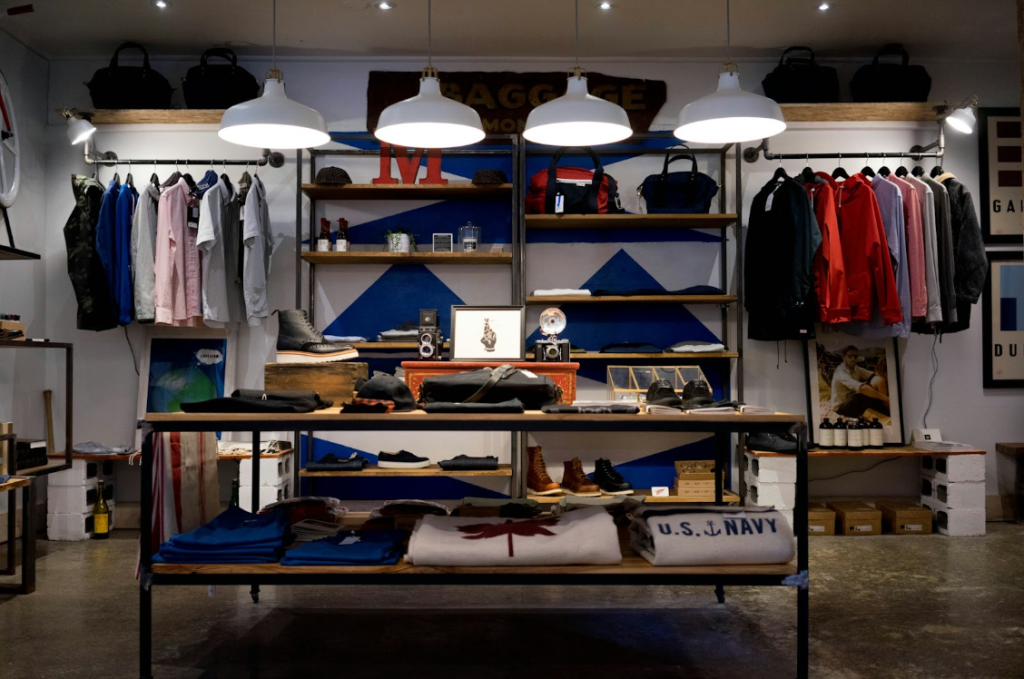What Is Visual Merchandising in Retail? 7 Tips for 2025 Growth
Visual merchandising is the practice of displaying products in a retail store to attract customer’s attention. Think of it like the Jedi mind trick of retail—except instead of controlling minds, it controls buying behaviors..
According to research by the FedEx Office, 68% of customers bought a product just because of an attractive sign. So keep reading to know how visual merchandising can turn window shoppers into loyal buyers.

- What Is Visual Merchandising?
- The Role Of Visual Merchandising For Retail Stores
- Types Of Visual Merchandising Displays
- 7 Visual Merchandising Tips To Attract Every Look of Customers
- 1. Direct Customer Traffic With The Store Layout
- 2. Adopt Lighting Techniques to Draw Attention to Products
- 3. Use Color Schemes to Create a Cohesive Visual Experience
- 4. Consider All Five Senses Of The Buyers
- 5. Highlight Products With A Consistent Theme
- 6. Leverage Product Groups To Increase Sales
- 7. Tell Your Brand Story
- Final thoughts
What Is Visual Merchandising?
Retail visual merchandising is the technique of organizing products in online and offline stores to make customers start buying. Beginning in physical stores, eCommerce visual merchandising is now also popular.
What Is An Example Of Visual Merchandising?
IKEA is one of the most typical examples of visual presentation. Each store features exciting and creative showrooms, helping individuals slowly pass the time while picturing their ideal homes. Zara is also one of the great examples of visual merchandising by telling a story through fashion visual merchandising that worldwide customers can recognize.
What is offline visual merchandising?
Offline merchandising is showcasing products in stores or showrooms to attract customers. Offline merchandising includes arranging product props, banners, colors, signs, fragrances, lighting, and mannequins.
What is online visual merchandising?
Online merchandising is the concept of presenting products to capture customers’ attention on a website or an app. Web-based merchandising involves using elements like videos, images, word content, ratings, reviews, prices, promotions, custom banners, recommendations, and optimized search options.
By utilizing the power of data and AI, online visual merchandising can maximize profitability by showing the right products to the right customers in many attractive ways. A case study by Prefixbox showed that AI search could even triple a brand’s revenue by visual recommendation.
The Role Of Visual Merchandising For Retail Stores
Essentially, your retail space should act as the most efficient salesperson, and visual merchandising techniques employ the art of optimizing product displays for maximum revenue. There are 3 roles in how creative visual merchandising helps retailers:
- Higher sales: Visual merchandising in retail helps showcase your brand and attract the right customers. When these buyers turn loyal, you have a steady revenue source to explore more selling strategies.
- Higher engagement time: Store layout design and visual merchandising can influence the time a customer spends in-store and on the website. You can create “touching moments” where consumers interact with merchandise meaningfully.
- Better social presence: Visual merchandising experience inspires shoppers to share about your stores. Consumers can see online posts of your products and you can reach a wider audience.
Types Of Visual Merchandising Displays

You can explore several visual merchandising strategies depending on the specific products, stores, and branding. Here are all of them:
- Interior Displays: Displays inside your store such as merchandise and decorations. Your store layout plays a great role in impacting customer movement and the shopping experience, which we will get to in a moment.
- Exterior Fixtures: Outdoor fixtures such as posters, signs, and canopies. Outdoor decoration can also work with interior displays to communicate your company’s branding and give a strong initial impression.
- Window Display: A good visual merchandising window display will grab a passerby’s attention and increase the number of store visitors. Window displays help present new products and promotions, and show off the brand personality.
- Point-of-Sale Displays:Point-of-sale or the checkout section is often neglected when thinking about visual merchandising, but it’s the one area every buyer interacts with when purchasing. A nice POS system for clothing stores displays pictures, prices, store policies, and promotions to create a pleasant shopping experience, quickening the buying decision.
- Interactive Displays: A unique in-store experience can bring the physical and digital worlds together through interactive displays. These displays include investments such as smart large touch screens, smart mirrors, VR showrooms, and 3d visual merchandising, as well as smaller tactics such as personalized search and helpful chatbot.
- Mannequins: Mannequins are a classic fashion visual merchandising tool to mimic the human body with various sizes, shapes, and genders. They can also help convey brand messages.
- Seasonal Displays: Seasonal display is another visual merchandising retail display idea to show off new merchandise and encourage add-on purchases during holidays like Christmas, Chinese New Year, or Mother’s Day.
- Product information (both online and offline): Where and how you display product information matter. In-store product tags, labels, info sheet, and website typeface, button, visual recommendation, or tone of content can all affect purchasing decisions.
7 Visual Merchandising Tips To Attract Every Look of Customers
1. Direct Customer Traffic With The Store Layout
All together it is possible to choose 8 variants of store layouts and every variant offers you different possibilities. You should first consider the number of products, store size, preferred style, and movement patterns to have the suitable layout.

- Grid Floor Plan is best for shelf-stocked products such as toys, hardware, books, and homewares
- Racetrack Floor Plan is best for fashion, accessory, toy, homeware, kitchenware, personal care, and specialty retail
- Diagonal Floor Plan is best for Self-service stores, electronics, beauty, and cosmetic sellers
- Straight Floor Plan is best for home decor, experiential retail stores, and showrooms
- Angular Floor Plan is best for luxury retailers like high-end apparel and jewels
- Herringbone Floor Plans is best for wholesalers with large inventories
- Mixed Floor Plan is best for specialty retailers to highlight brand collaborations with an unique experience or “pop-in” retailers
- Free-flow Floor Plans are best for fashion, accessory, personal care, specialty, and bakeries that display packaged goods
2. Adopt Lighting Techniques to Draw Attention to Products
Light can direct the attention of shoppers to certain areas of your store or on certain displays. Use these 4 lighting techniques to compel consumers to buy.
- Ambient lighting acts as the main lighting source for your store.
- Accent lighting highlights key areas or specific products to indicate to draw the eye of shoppers.
- Task lighting provides light for a specific task, such as bathroom lights.
- Decorative lighting serves an aesthetic purpose.
Lighting can also dictate the mood. Brightly lit displays create energy and action, while subdued lighting options create a more relaxed vibe.
3. Use Color Schemes to Create a Cohesive Visual Experience
A uniform color palette will create a cohesive visual experience in your shop. Bright colors can draw the eyes better than darker ones. So use eye-catching colors with lighting to highlight specific products and use darker colors to keep the customers moving.
For example, let’s say you are an apparel store and you want your visual merchandising fashion to be stylish. Contrasting shades like black and white would be ideal to show off items, while pink or maroon brings a feminine vibration.
But remember:
Limit the number of colors to better create a harmonious visual experience. Also, choose a palette that fits your brand, which must not be the same as competitors.
4. Consider All Five Senses Of The Buyers
It can be easy to focus on creating eye-catching visual merchandising displays and forget about the other four senses. But the secret to an immersive shopping experience is a multi-sensory encounter:
- Sight: Combine store layout, lighting, and colors to direct and control where a visitor looks and for how long
- Sound: Music in the store has a profound but subtle effect on customer behaviors
- Touch: Give customers the ability to touch, feel, and try out your items
- Smell: Scent can evoke emotion and memory of buyers
- Taste: If you sell consumables, sample tasting is the equivalent of trying on clothes before buying.
5. Highlight Products With A Consistent Theme

Visual merchandising is not just about making one or two store sections attractive. It’s about creating a consistent brand experience throughout one or many stores. When designing your store’s visual presentation, consider how each section combines to create the flow of traffic, key products’ visibility, and the overall emotion you want to create.
Visual fashion merchandising is a perfect example, you can:
- Place a new collection by the window to capture attention.
- Create a natural path leading to other areas like sale items.
- Arrange related items to encourage add-on sales.
6. Leverage Product Groups To Increase Sales
Strategic product placement throughout the store draws attention to related items so that customers will be more likely to purchase them. Here are some key product grouping strategies to consider:s
- Complementary items such as shoes and accessories should be together.
- More expensive items stay at an eye-level shelf to encourage more expensive purchases.
- Put impulse-buy products around the checkout area or POS device
- Use best-sellers to promote slow-sellers by putting them in a correlation layout.
For your online store, visual merchandising eCommerce can mean creating new product groups with the same type, price, size, or colors together.
7. Tell Your Brand Story
Lastly, you want your stores to tell a story about your brand and what people can expect from you. This is where storytelling plays its part in connecting customers with the purpose of your business.
For example, if you are a wine store, you may want customers to purchase and feel like they just visited a luxurious chateau estate. To best tell your story, ensure all elements are part of a complete visual narrative.
Final thoughts
The challenges of visual merchandising may be very different for each business. An apparel store often struggles with maintaining visual appeal and managing inventory, while an electronic store sells complex products that require too many explanations.
Only by staying ahead of emerging trends can retailers create visual merchandising strategies to maintain a competitive edge in the retail landscape. AI personalized search is a technology for your online store to create a shopping experience that is visually appealing and intuitive, click on the link to find out more.

Katie is a retail expert at magestore.com – No.1 POS solution for Magento & Shopify. She provides helpful insights to retailers to operate a store operation seamlessly. Katie has over 5 years of experience working with various retailers, producing high-quality content to educate customers on basic definitions of the industry and giving advice about best practices and solutions for each type of business.

